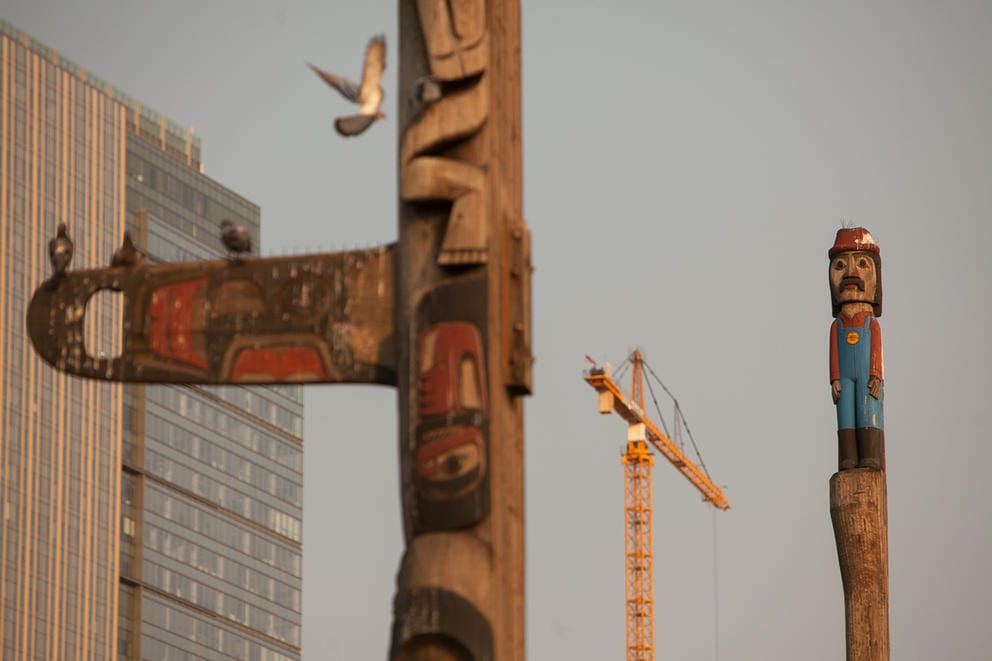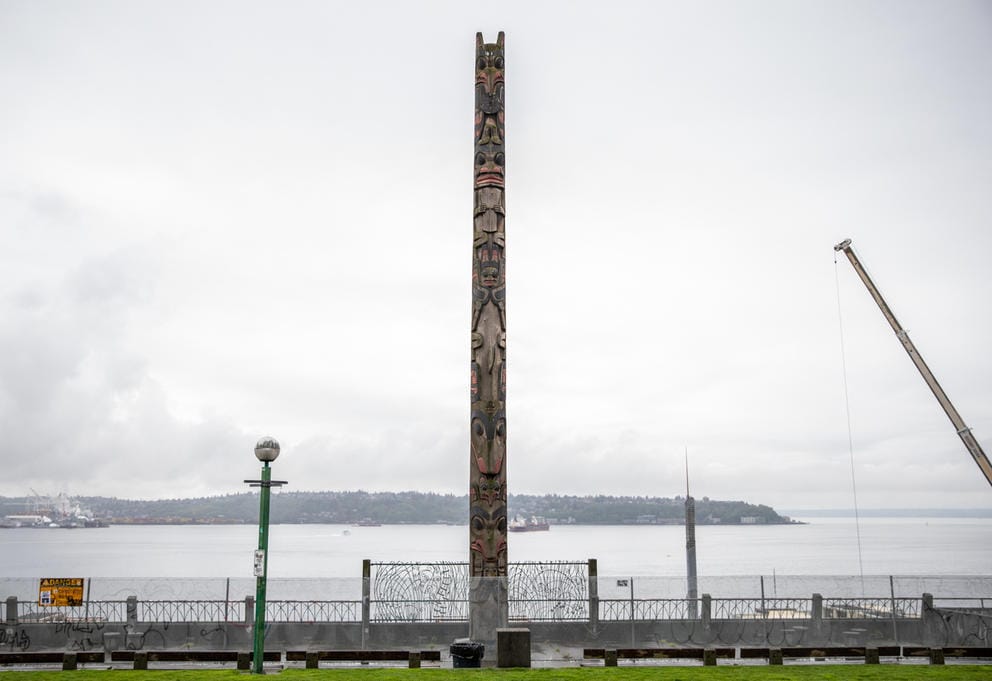The two culturally misleading totem poles near Pike Place Market will be removed by early March as part of a broader renovation project at Victor Steinbrueck Park. But the poles will be reinstalled after that work is completed, because of a condition concerning the renovations made by The Pike Place Market Historical Commission.
The proposed renovations helped start a conversation about the appropriateness of having the poles there, as the first people of what is now Seattle did not carve totem poles. But both The Pike Place Market Historical Commission and Friends of the Market have said keeping the poles in the park helps maintain the history of these public spaces.
“Our defense of the poles is merely calling attention to the fact that they have been defined by the Market Historical Commission as a character-defining feature of the park and therefore, as long as that remains the case, that they should be replaced when they're removed for the renovation,” said Eddie Dornfeld, president of Friends of the Market.
Dornfeld added that he doesn’t have any particular belief about the poles, and that the commission could change its characterization of them.
“It amends the guidelines from time to time,” he said.
The 50-foot cedar poles were once thought to have been crafted by Marvin Oliver, a well-known and respected Quinault Nation carver, but recent reporting by Crosscut has found that James Bender, a non-Native man, was commissioned by Steinbrueck, who led the effort to save the Market, to work on the poles. Bender claims he never worked with Oliver. In fact, Bender told Crosscut he was the one in charge of the project, working with Steinbrueck only on the design, and that he had carved both poles himself.
Oliver died in 2019, but not before distancing himself from the poles, telling The Pike Place Market Historical Commission that while he was commissioned to do the job, “This is Victor’s pole, it’s not my pole.”

Native leaders have pushed to remove two totem poles from Victor Steinbrueck Park. They argue the poles do not accurately represent the region's Native culture. (Jovelle Tamayo for Crosscut)
Historical significance
Responses to 2016 Seattle Parks and Recreation surveys on the topic ranged from calling the totems a “fraudulent interpretation of history” to parroting the “drunk Indian” stereotype, which continues to affect the way the city views its Native neighbors. Some people also called for a consultation with Coast Salish people and an effort to include Native American design elements that honor them.
In 2018, Seattle City Council members Debora Juarez and Sally Bagshaw and a group of Indigenous leaders met and agreed that the poles Steinbrueck commissioned and installed in the park in 1984 should be removed and relocated to the Museum of History and Industry to honor their historic significance.
But the fate of the poles has not changed. The totems were brought up briefly in only three commission meetings from 2018 to 2022, which did not include Coast Salish or other Native representation, to discuss the park renovation and the totem poles. The Commission maintained the poles are a “character-defining feature” of the park and should be reinstalled before the park is reopened. Although these are public meetings, the public isn’t notified unless they sign up for updates from the Commission.
During the public-comment portion of an August 2019 Commission meeting, a community member highlighted the lack of effort to reach those who have raised concerns about the totem poles and pointed out that everyone attending the meeting was white. They urged the commission to “defer action and seek out those who should be involved in the conversation before approving the renovations,” according to Commission meeting minutes.
More than three years later, that still hasn’t happened.
“If they're a historical group, they should be reaching out to the Native people,” said Andrea Wilbur-Sigo, a member of the Squaxin Island Tribe and seventh-generation traditional Coast Salish carver.

A totem pole at Victor Steinbrueck Park near Pike Place Market on Friday, May 6, 2022. The park's two poles, commissioned by Victor Steinbrueck, were carved in 1984 by non-Native artist James Bender. (Amanda Snyder/Crosscut)
Public perceptions
Seattle Parks and Recreation has responded to the comments to their surveys by updating the 2019 renovation plans to include Coast Salish welcome text at the entrance walls; a special concrete path paved in a Coast Salish basket-weave pattern; a Coast Salish map; and Coast Salish column wraps at the Pavilion. The Coast Salish art design elements will be commissioned by Jones and Jones, a largely non-Native architect and landscape company with the exception of Johnpaul Jones who is of Choctaw and Cherokee heritage. No Coast Salish designers or artists have been commissioned for these new design elements.
Parks and Recreation outreach efforts also included feedback from Chief Seattle Club focus groups, Seattle Urban Native Nonprofits, and a Seattle Indian Health Board roundtable, according to Karen O’Connor, senior public relations specialist for Seattle Parks and Recreation.
Seattle Parks and Recreation is also working with the Seattle Office of Arts and Culture to submit an application to the Market Commission for permanent relocation of the poles, but there is no timeline for when that may happen. The Commission would review the application at a public meeting and either approve or deny it. According to Sam Read, communications director for the Seattle Department of Neighborhoods, if the commission approves the request, the poles could be relocated before the park renovation is complete; the poles would then not need to be reinstalled as a condition of reopening the park.

Victor Steinbrueck Park in a 2018 photograph. (Jovelle Tamayo for Crosscut)
Condoning illegal behavior
If the totems are returned to the park, Wilbur-Sigo believes the Commission could be condoning unethical or even illegal behavior by representing something as Native art works that were not created by a Native carver. Under the Indian Arts and Crafts Act of 1990, it is illegal for non-Native people to sell or be hired to create Native-inspired art without being clear that they themselves are not Native.
“Do you want to condone that behavior, or do you want to empower Native people? Is that what you want your children to remember you by? The group who wants to raise non-Native poles in a prominent Seattle space, or do you want to create a new story?” she asked.



